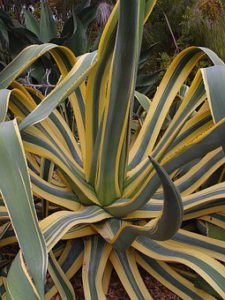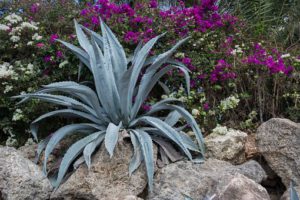Growing and Caring for the Agave Plant

Agave belongs to the family Asparagaceae and is a genus of monocot native to regions that are hot and arid, this drought-tolerant plant dates back as far as the Aztec Civilization that is now northern Mexico. The sap called pulque was central to religious rituals rights and sacrifices, agave or the century plant is used widely in low maintenance gardens because of its ability to go weeks without water. This garden beauty is native to South and Central America and also Mexico.
American Indians use agave fiber to make twine, today the fiber is used by manufacturers in the textile industry, other companies use the fiber of agave in green products to make slippers, washcloths, spa products, belts, and artisan crafts.
There are more than 450 species of agaves, some of them have spiny thorns that are dangerous and can cause server injury which we will be discussing a bit later. Agaves are succulent plants that have long leaves, some species of agaves display a beautiful flower that really stands out but the flip side of the coin is once the flower is produced the parent plant dies leaving behind pups. Agaves are a must-have for your garden and landscape areas. For more on the installation and care of agave continue reading.
My awful experience with the agave
A few years ago while working on a garden project at our international airport I was removing a few agaves to relocate to another area, many of these plants were anchor solid in the ground so removing them with a pickax and shovel was very difficult. Though moving slowly because of how they were anchored to the ground, with much fighting I was having some success.
These plants were really hard to uproot, I had to apply force. But what happened next would cause me, even more, to move with caution when working with these plants. This particular agave was really giving me a fight but I was determined to get it out of the ground to relocate it to its new home, so what I did was drive the shovel with force at the base because I was sure this would uproot the agave after such a long and tiring battle.
What I did not notice was one of the leaves was positioned where I could not see it so with that strong thrust a thorn from this plant went into my hand. Oh the pain, I was in such pain as never before. To make a long story short I reported this mishap right away to my then-manager I left work and sorted medical attention. I would later leave the doctor’s office that evening with a hand that was swallowed and in a sling with much pain, I also got about one week and a half to two weeks off. My point, when working with agaves be VERY, VERY CAREFUL. Not to worry, however, as long as you take extra precautions you will be fine, so if you’re still interested in installing these garden beauty then stick around as we enter the fascinating world of agaves.
Planting Location
When installing agaves look for an area that gets plenty of sunlight because these plants can survive desert conditions.
Soil Type
Because agave is a drought-tolerant plant the soil should be sandy soil or soil that drains well.
Watering Methods
The agaves that I work with have not gotten water for some time except when it rains because these agaves are established. When first install ensure they get sufficient water but allow the soil to dry out before giving your agave plant another drink. As said earlier once they are established they can go a very long time even weeks without water because remember these plants are drought tolerant.
Fertilizing Methods
If preferred you can feed your agave with diluted plant food but then again the ones that are in my care are mature and healthy looking and I have never fertilized them.
Garden insect pests of the agave plant
This garden insect pest can be a real menace for the agave.
- Snout weevil
The snout weevil lays eggs and the grubs or the babies cause bacterial wilt, this will cause the plant to collapse. What is so subtle about this pest is that by the time they are noticed the damage is done. The only thing left to do is to remove the plant and destroy it, look for the adults and the grubs to eliminate.
Diseases of the agave plant

Keep an eye out for these diseases.
- Rot Root
- Fungus Fusarium
- Erwinia
Root Rot
Keep an eye out for root, remember agaves are drought tolerant and do not like wet feet so only water when the plant shows signs of needing water like when the soil is extremely dry and agave starts to wilt.
Fungus Fusarium and Erwinia Disease
Fungus fusarium and Erwinia are encouraged after the agave has been weakened by the snout weevil, again it’s all a matter of eliminating this insect pest.
Where to install them
Some agaves because of the thorny leaves can be very dangerous therefore it is so important that these plants be placed properly to avoid injury especially when it comes to kids and pets. Here are just a few of the many ideas to consider.
1. Because some agaves can get really large they make a good backdrop in a plant bed.
2. Smaller agaves can be used as a front drop-in garden beds.
3. Agaves go great in a rock garden.
4. Can be installed in containers.
5. Agaves can be used in a low-maintenance garden.
6. Some agaves can be grown as a specimen plant.
Pruning Agaves
Pruning agaves can be a very sticky experience if you are not careful, I have had many sticky experiences which was not pleasant. When attempting to prune agaves wearing a long sleeve shirt is a must, also the use of thick heavy-duty gloves is important, and the use of eye goggles to protect your eyes because the last thing you want is an eye injury. The leaves of some agaves like the one in the above photo should be approached and groomed with caution. With a sharp hand pruner carefully cut or remove, the spent or dry leaves from the base. Leaves that are growing out of shape or maybe a hazard should be prune also.
Container grown agave plants
Container-grown agaves are great and will enhance your garden and landscapes, before installing agaves know the height and the size at which your agave will grow at maturity to know what size container to use. The container should have drain holes to allow excess water to drain. Because these plants are drought tolerant use soil that is sandy or well-drained. Once your agave is installed gave it sufficient water and allow the soil to dry out and don’t water again until the soil is dry.
The final word
Agaves are amazing plants and will bring that flavor to your landscape and gardens, these plants can withstand the drought which makes them a low maintenance plant. Like I said I have worked with them over the years and have had a bitter (hand injury)-sweet (beautiful garden designs) experience but as long as you play it safe you will enjoy these plants for years to come.
About the author
Norman loves being in the garden, both at home and for his job....
he is 'Natures Little helper' being outdoors, growing his vegetables and flowers from an early age.
Now having spent over 22 years in the profession he want to give some of his knowledge to others...
his vast array of hints and tips you will find scattered over this site will help you no end growing plants in your garden.
